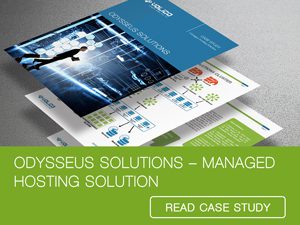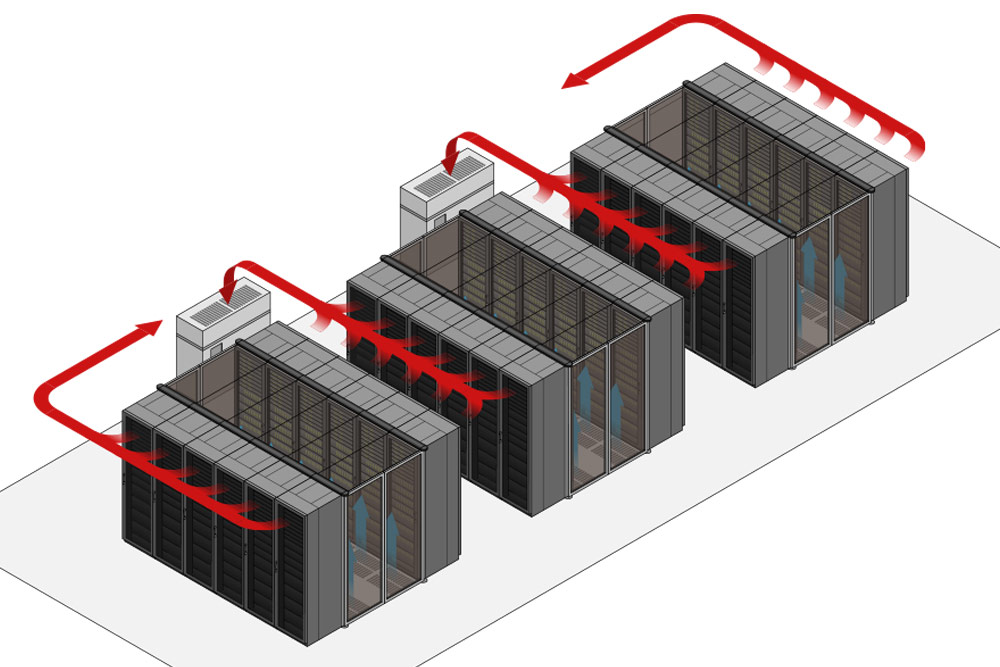The acceleration of digital transformation in the past few years has led to major changes in enterprise infrastructure choices. There’s increasing demand for scalable, highly secure, and preferably affordable infrastructure. Enterprises today are looking for something more than just a place to host their infrastructures. To keep pace with the many ongoing technological and economic changes, most organizations require a higher degree of flexibility, and with power consumption (and prices) rising, cost-efficiency is an important consideration, as well. The two most common solutions that can accommodate these demands are public cloud services and colocation.
The public cloud is an affordable solution that allows businesses to lease shared computing resources from cloud service providers in a pay-as-you-go manner. Colocation refers to a solution where businesses rent data center space from a provider to host their own servers and hardware, with the facility providing power, redundancy, cooling, surveillance, and various managed services.
The question here is whether colocation vs. public cloud ROI offers a better outcome for the enterprise. This blog will examine both options, their benefits, and offer a comparison of the two solutions from a ROI point of view. By the end, you’ll find out whether colocation vs. public cloud ROI will be more worth it in your organization’s specific case. Let’s dig in.

What is Colocation?
Before comparing colocation vs. public cloud ROI and which one’s more worth it, let’s examine how both options work separately.
Colocation, or “colo”, is a type of data center where companies can lease space in the provider’s facilities to host their own physical servers and networking gear. Colocation’s biggest advantage is that it replaces the need for building and operating on-premises server rooms and private data centers, offering the alternative for organizations to move their infrastructure into a third-party facility that provides them the necessary space and support. These facilities handle the critical environment, providing reliable power and cooling systems, network connectivity, and round-the-clock physical security. This way, the hardware stays operational and protected at all times, without requiring the owner’s constant on-site supervision.
The colocation model gives businesses access to an advanced, shared infrastructure while keeping full ownership and control over their equipment. Companies bring in and manage their own servers, firewalls, and storage arrays, while the colocation provider handles the physical environment where the equipment operates.
The colocation data center provides:
- A rack, cabinet, cage, or private suite where the equipment is stored
- Redundant power sources (including battery backup and diesel generators)
- High-speed internet connectivity, often from multiple carriers (carrier-neutral)
- Advanced cooling and HVAC systems to prevent overheating
- 24/7 physical security, surveillance, biometric access, cabinet controls, and guards
- Fire suppression systems and disaster-resilient infrastructure
The Benefits of Using Colocation
Comparing colocation vs. public cloud ROI is more clear after looking at the benefits of each. Here’s what colocation excels in.
No Infrastructure Overhead
One of the biggest advantages of colocation is the ability to access enterprise-grade infrastructure without having to build or maintain it. Constructing a private data center is capital-intensive and involves ongoing operational costs for power, cooling, network connectivity, maintenance, security, staffing, etc. Colocation makes this burden easier by letting businesses share a professionally managed facility. This allows enterprises to benefit from scale and redundancy at a fraction of the cost.
From an ROI standpoint, this drastically reduces capital expenditures (CapEx) and shifts them to more predictable operational expenditures (OpEx). Companies can allocate resources more flexibly and maintain ownership and control over their hardware at the same time.
High Reliability and Guaranteed Uptime
Colocation facilities are built to deliver high availability. Some of them offer a 99.999% uptime guarantee. They feature redundant power systems (UPSs, backup generators), multiple internet carriers, advanced fire suppression, and climate control. The strength of colocation lies in the fact that this level of resilience is difficult (or impossible) and much more expensive to replicate in-house.
The impact on ROI here is tied to reduced downtime, which directly correlates with cost savings. Every minute a system is offline can cost thousands in lost productivity, transactions, and customer experience. Colocation is there to minimize this risk.
Security and Compliance
Protection from cyber threats is essential these days. Professional colocation data center solutions come with robust physical and cybersecurity measures included: biometric access controls, video surveillance, manned security, server monitoring services, and multi-layer firewalls. Most facilities are also compliant with industry standards like SOC 2, HIPAA, ISO 27001, and PCI DSS. This way, businesses can meet regulatory requirements more easily without investing in compliance expenses on their own. This is particularly valuable for organizations in finance, healthcare, and e-commerce, where data protection is not just a best practice but an obligation with legal consequences.
When looking at colocation vs. public cloud ROI, the better the compliance preparedness, the easier it is to avoid costly fines and reputational damage, which protects long-term ROI.
Scalable Growth
Colocation has the advantage that it offers the flexibility to grow as needed. Businesses can start small with a single rack and expand to multiple cabinets or even private suites as demand increases. There’s no need to build out new facilities or invest in additional cooling and power capacity; scaling is just a matter of adjusting the service contract. This scalability protects ROI: instead of overbuilding or overspending up front, companies can scale as needed in response to actual growth.
Carrier-Neutral Connectivity
While not all facilities offer carrier neutrality, the ones that do offer their clients the opportunity to connect to multiple internet service providers (ISPs) or cloud on-ramps within the same facility. This improves performance and redundancy, and puts businesses in a more advantageous position to negotiate better bandwidth pricing.
Over time, this reduces networking costs and improves latency and availability, all of which contribute to more efficient operations and, by extension, stronger ROI.

What is the Public Cloud?
To compare colocation vs. public cloud ROI, we also need to look at how the public cloud works.
The public cloud is a model where businesses access computing resources: virtual servers, storage, databases, or applications over the internet through a third-party provider.
Organizations can rent resources that run on the provider’s infrastructure and are shared across multiple clients. These services are billed based on usage, offering yet another flexible alternative to building and managing physical systems in-house.
Public cloud platforms give businesses access to powerful infrastructure and tools, freeing them of all the burdens of ownership. Providers handle the physical hardware, network maintenance, and system updates, and users manage their applications and data within a virtual environment. This setup supports rapid deployment, easy scaling, and high availability, with services delivered across a global network of data centers.
The Benefits of Using the Public Cloud
To get to the bottom of colocation vs. public cloud ROI, let’s see what benefits public cloud users have.
Lower Upfront Spending
One of the best advantages of the public cloud is the ability to avoid large capital investments. There’s no need to buy servers or networking equipment, which frees up capital and reduces the financial risk associated with infrastructure-heavy projects. For companies looking to stay agile or keep their cash in-house, the public cloud’s pay-as-you-go structure is the quicker path to return on investment.
Faster Time to Value
Deploying resources in the cloud takes minutes, not weeks. The speed translates to faster product rollouts, streamlined testing cycles, and shorter development timelines. This makes it possible for businesses to generate revenue faster, react to changes sooner, and reduce the cost of delays. All of which strengthens the return on every dollar spent.
Scalability Without Waste
Public cloud platforms allow organizations to adjust resources on demand. There’s no need to overbuild or commit to long-term capacity forecasts. When workloads spike, more computing power is readily available. When things slow down, usage (and cost) drops. It’s straightforward: efficiency reduces waste, which directly improves margins and maximizes infrastructure ROI.
Global Reach Built In
With access to data centers across multiple regions, businesses can serve customers closer to where they are. This makes international expansion more accessible and improves performance by achieving low latency. Instead of investing in physical infrastructure overseas, companies tap into a ready-made backbone that supports growth without heavy upfront costs.
Reduced Maintenance Overhead
Since the provider manages the underlying hardware, system health, and patching, internal teams can spend less time on routine support and more time on high-impact work. That shift in focus helps reduce staffing needs and increases productivity – both critical factors in long-term ROI.
Access to Modern Tools
The public cloud brings immediate access to advanced technologies: artificial intelligence, machine learning, data analytics, automation, everything that would be costly and complex to build from scratch. These tools help organizations gain insights, streamline operations, and create new services faster, unlocking new revenue streams and improving overall business performance.
Colocation vs. Public Cloud ROI: Breaking it Down
Now, let’s look at the main criteria for differentiating between colocation vs. public cloud ROI.
Ownership and Cost Model
In the colocation model, businesses purchase and own their hardware, storage, and networking equipment. What makes the difference from an in-house model is that they house the servers and other equipment in a third-party data center. This model requires upfront capital investment in hardware (CapEx), and it also comes with recurring operational costs for power, bandwidth, managed services, and rack space (OpEx).
Public cloud platforms like AWS, Azure, or Google Cloud operate on a pay-as-you-go model. Instead of buying hardware, businesses can rent virtualized resources and services billed by usage (compute, storage, bandwidth, etc.). This shifts the financial burden from CapEx to a more flexible OpEx model, but without owning the hardware.
The public cloud typically offers a faster ROI for startups or organizations with limited capital. Colocation, while more expensive upfront, may yield better long-term ROI for predictable, steady workloads and avoiding the premium pricing of cloud resources at scale.
Scalability
Scaling in a colocation model requires acquiring, installing, and configuring the added physical hardware. This is crucial for organizations needing custom configurations, higher security, or just more control for any other reason. This, however, takes time and depends upon predicting demand to avoid under- or over-provisioning.
The public cloud is more straightforward in terms of on-demand scalability. Resources can be spun up or down in real time to accommodate changes in demand, traffic spikes, or sudden growth across regions. It can also be done automatically. For businesses with fluctuating or unpredictable workloads, the cloud’s elasticity offers better resource utilization, directly improving ROI. On the other hand, colocation offers more value for stable workloads where performance needs are well understood and unlikely to spike unexpectedly.
Control and Customization
Because businesses in the colocation model own and manage their hardware, they have full control over every aspect: system architecture, operating systems, security policies, performance fine-tuning, etc. This level of control is ideal for highly customized or regulated environments.
While the cloud comes with a wide range of services and configurations, users are still working within a shared infrastructure and subject to the provider’s platform limitations, APIs, and policies. Deep customization or low-level access is not one of its strengths.
When comparing colocation vs. public cloud ROI, colocation delivers better ROI for organizations with unique compliance needs, legacy apps, or hardware-specific requirements that the cloud cannot accommodate so easily. However, the cloud offers faster deployment and agility for new, and specifically cloud-native applications.
Security and Compliance
Colocation facilities (more often than not) have to meet high security standards (SOC 2, ISO 27001, HIPAA, etc.). Clients maintain full control over firewalls, encryption, and access controls. With colocation, the responsibility of configuring and maintaining security systems properly is on the client.
With the public cloud, the security is “built-in.” Providers invest heavily in security and compliance and offer advanced tools for encryption, monitoring, and identity management.
Cloud compliance services can lower the cost and complexity of meeting regulatory standards, improving ROI for companies that can’t assume the burden of managing hardware. Colocation better suits businesses with strict internal controls or niche compliance needs that require physical or architectural control.
Reach
Colocation is location-bound to physical data centers. Therefore, global expansion requires provisioning hardware in multiple facilities or working with a distributed colocation provider.
Cloud providers, on the other hand, offer global infrastructure by default, helping businesses to deploy applications across continents with low latency.
For global businesses or those scaling rapidly, the cloud enables faster, more cost-effective expansion, improving time-to-market and operational ROI. Colocation may be more ideal for centralized workloads or localized data residency requirements.
Maintenance and Staffing
With colocation, clients are responsible for fine-tuning and maintaining every aspect of their hardware. While colocation providers do offer “remote hands” and smart hands support services, businesses still need skilled IT teams for handling upgrades, troubleshooting, and monitoring.
The cloud, on the other hand, abstracts away all physical maintenance, all of it being redirected to the provider, and often running automatically. This way, cloud services help companies reduce IT staffing needs and shift their focus to innovation. This helps with increasing productivity and reducing overhead, which is a plus from a ROI point of view. Colocation requires more hands-on management, which can increase costs if internal resources are stretched thin.

Choosing Between the Two Solutions
The choice between colocation vs. public cloud ROI can be challenging. Let’s sum up the most important aspects to consider before signing an SLA.
To break it down very simply, colocation brings better ROI for enterprises that:
- Need complete control over their IT infrastructure and face stringent compliance requirements
- Have already invested in hardware and want to profit from the investment
- Need steady workloads with predictable costs
- Are operating in industries like healthcare and finance, facing strict regulatory requirements.
The public cloud, on the other hand, is a better choice for enterprises that:
- Operate with fluctuating workloads that need fast and flexible scalability
- Don’t own hardware, or don’t want to assume the investment upfront
- Need a lightweight approach without managing physical infrastructure
- Require global reach
- Want to rely on cloud-specific technologies
The Hybrid Approach: Combining Colocation and Public Cloud
As always, a hybrid approach is also possible for those who can divide their workloads between infrastructures and want to get the best of both worlds.
This is a common practice that allows organizations to run critical applications on the more secure and controlled collocated hardware, and use the cloud’s benefits for innovation and applications that require more flexibility.
The cloud has shared resources between its users, and no matter how much cloud providers invest into their security, a private environment is still the safer option. A company dealing with sensitive customer data can, for example, have this data housed in a colocation data center’s secure, private environment and run analytics workloads in the public cloud. This approach is the preference of many enterprises requiring security and control, but also the elasticity of the cloud.
Conclusion
Agility is key in a constantly changing and evolving IT landscape, and infrastructure is foundational to agility. To stay in the lead, enterprises have to repeatedly evaluate their infrastructure and needs to ensure that they are using resources in a cost-efficient way. Security and scalability are more important than ever, and the right infrastructure decision is crucial for remaining safe and competitive. Whether an organization chooses colocation or public cloud, ROI is what counts in the end. A hybrid approach could be the solution for many, offering the combined benefits of both to suit unique demands.
Contact us today to learn about our colocation, cloud and hybrid solutions.










